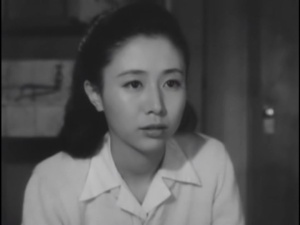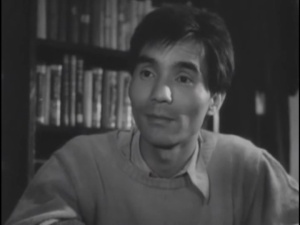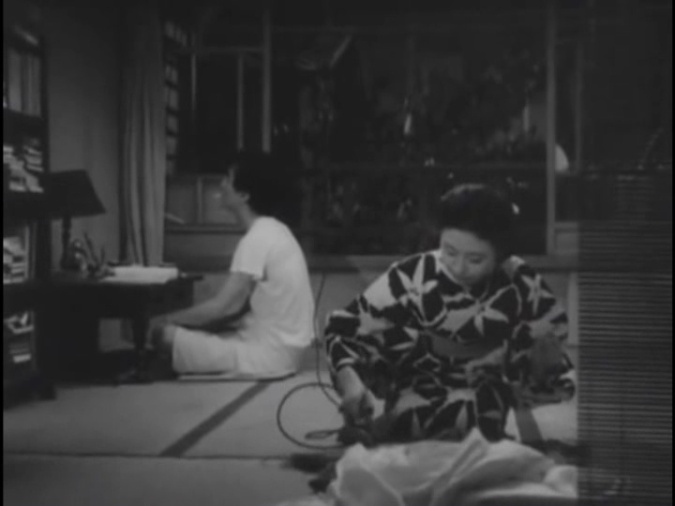
Nobuko Otowa as the beloved wife
Just as the title says, this is the story of a year in the life of a perfect wife, and just as you would also expect, it is a year that ends in a death scene. The primary interest is that this is an autobiographical movie by Kaneto Shindo about not only his first wife but also his entry into the film industry. Unfortunately we find out very little about the actual movie-making during the war years.* Our visits to the back lot consist of a couple of scenes in an alleyway with crew drinking from a water cooler or samurai tossing a baseball (during the Occupation, baseball was expected in all movies). We see nothing of the on-set workings, which would be especially interesting here because the director involved is a very lightly disguised Mizoguchi.
Although the woman is called a beloved wife, she is not legally his wife. Due to the family registration system, the couple is never officially married. And as is usual in the josei-eiga, she is far more openly committed to her beloved husband than the other way round. She runs away from home to be with him, though he does not ask her to, and she actually proposes to him. She fights for him at the studio when he is about to give up, and she somehow manages to sustain them without having a job while he spends a year on unpaid probation (She stops knitting when he doesn’t like it, and since he studies and writes at home, there is no hint or chance of a little prostitution on the side to add to the family coffers). It’s not that he doesn’t love her, perhaps as deeply and passionately as possible, but he does not express it.
In part, this is due to the casting of Jukichi Uno as the fictional Shindo.

Jukichi Uno
Uno was about the most self-effacing actor in the history of cinema, a man who brought restraint to new levels, even for Japanese films, and could make Chisu Ryu look like he was chewing scenery. This made him an ideal character actor but something of a blank space as a romantic lead. On the other hand, we have Nobuko Otowa as the wife Takako. This was her first leading role (at 26, fairly late for a female in the business) and the absolute commitment and sensitivity she would bring to all of Shindo’s later movies is on evidence from the opening moments.
The director here, as I mentioned, is presumably modeled on Mizoguchi, whom Shindo always regarded as his mentor. During his probationary year, he is assigned to “Mizoguchi,” but the guidance he is given consists mostly of, “This is terrible, do it again,” which is hardly helpful. Other reports indicate that this is in fact how Mizoguchi dealt with his screenwriter, but that writer was not Shindo but Yoshikata Yoda (with whom Shindo did share one credit for Flame of My Love after the war). Until then, Shindo never wrote a produced script for Mizoguchi, though it is certainly possible that he tried to do so in this period. He was, instead, Mizoguchi’s set designer until Shindo was drafted. Surviving the war quite literally by dumb luck,** Shindo’s Occupation years would include several highly regarded collaborations with Yoshimura, including Ball at the Anjo House and Genji monogatari, which gives the lie to his opening narration that he has never written anything good. He also had at least four produced screenplays before 1943, which he gives as the date in the movie when he met his “beloved wife.”

The writer studies while his wife does the ironing of his only shirt
Since this is claimed to be an autobiographical film, it is perhaps fair to note that after the war Shindo married again legally. However, Nobuko Otowa became the new love of his life and was his mistress until the official wife died in 1978, when at last they were married. So we had a man making a movie about how wonderful his previous wife was as played by his current or soon-to-be mistress and then going home each night to his real wife. Even within the restrained manners of Japanese marriages of the era, there must have been some interesting dinners.
* I suppose I should add the back-lot story to the list of movies we don’t see from Japan. Ten Dark Women takes us behind the scenes at a TV studio, but not until Fall Guy (1982) will we see anything set behind the scenes in a film studio. In my posts thus far, I have found only a very brief scene in Naruse’s silent Street Without End set in a studio.
** After being drafted, Shindo was assigned to a unit of 100 men based in Japan. Three different lotteries left only Shindo and five others behind, while all those chosen in the lotteries were assigned to units where they all died. He often mentioned the men who were lost and would eventually deal with this on film in his last movie, Postcard, made when he was 97.
Pingback: Things We Don’t See (II) | Japanonfilm
Pingback: Hymn / Sanka (1972) | Japanonfilm
Pingback: Preparation for the Festival / Matsuri no junbi (1975) | Japanonfilm
Pingback: Hokusai / Edo Porn / Hokusai manga* (1981) | Japanonfilm
Pingback: Tree of Leaves / Deciduous Trees / Rakuyoju (1986) | Japanonfilm
Pingback: Actress / Eiga joyu (1987) | Japanonfilm